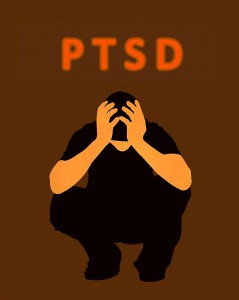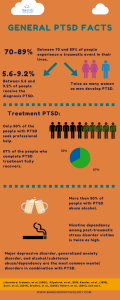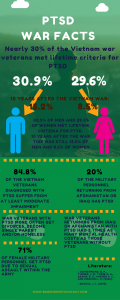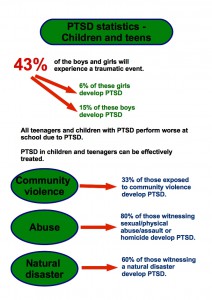Post-traumatic stress disorder statistics.

Post-traumatic stress disorder statistics.
A lot of people suffer from post-traumatic stress disorder these days. Most information you find is about war veterans, but not only war veterans develop PTSD. Many people who were victim of a car crash, natural disaster, sexual abuse, a robber, or other life threatening situations can develop PTSD. Although reliable information on PTSD is difficult to find online, there are a lot of post-traumatic stress disorder statistics in scientific magazines. Using studies and scientific articles, the most interesting post-traumatic stress disorder statistics have been collected on this page. These facts may help putting PTSD and its symptoms in perspective. For instance, experiencing a traumatic event is very common (89% of people [11], [12]), but not everyone develops PTSD. Also, PTSD is more common in women, compared to men [3],[4],[8],[9]. Here are more interesting post-traumatic stress disorder statistics.
At Barends Psychology Practice, we treat post-traumatic stress disorder Online and in person. Book your first, free of charge session now. Go to Contact us. (Depending on your health insurance, treatment may be reimbursed).
Jump-to menu:
Post-traumatic stress disorder statistics – General information.

General PTSD Facts
In this part you find information about how common PTSD is. Also, you find information on how often people reach out for professional help. And there are some interesting post-traumatic stress disorder statistics about the problems people with PTSD face.
United States of America:
- 89% of adults in the United States have experienced at least one traumatic event in their lives [11],[12]. This corresponds to PTSD criterion A. NOTE: experiencing a traumatic event does not always lead to PTSD.
- 6.4-6.8% of adults in the U.S. have been diagnosed with PTSD at least once in their lives [2],[6].
- In the United States, between 3.6 and 5.7% of men and 9.7% and 12.8% of women develop PTSD once in their lives [6],[12].
- 9.2% of the U.S. adults aged 45-59 have been diagnosed with PTSD, followed by people aged 30-44 (8.2%), 18-29 (6.3%), and 60 and over (2.5%) [6].
- Only half of the Americans with post-traumatic stress disorder ever seek treatment [3],[10].
- African Americans, Hispanics, and Native Americans develop PTSD (slightly) more often than Caucasians [10]. Asian Americans develop PTSD less often than Caucasians [10].
- People with post-traumatic stress disorder have the highest rates of health care service use in the US [10].
Australia:
- In 2018, 1,3 % of Australian adults got PTSD [2],[7].
- In Australia, adults aged between 25-54 were more likely to report traumatic experiences compared to people aged 18-24 [7].
- 51.6% of those diagnosed with PTSD in the past 12 months also had Major Depressive Disorder, 40.2% had Generalized anxiety disorder, and 37.6% developed alcohol abuse/dependency, in Australia [7].
- Only 14.8% of the people in Australia with PTSD in the past 12 months had no other mental disorder [7].
(Advertisement. For more information, continue reading.)
Canada:
- In Canada, 9.2% of people develops PTSD at least once in their lives: 12.8% female and 5.3% male [8].
- 2% of people in Canada developed PTSD in the past 12 months [2].
- 43.1% of those with lifetime PTSD developed PTSD after assaultive violence, followed by learning about others (34.5%), sudden unexpected death (30.3%), and shock or injury (22.5%), in Canada [8].
- Of those diagnosed with lifetime PTSD in Canada, 74% also had Major depressive disorder, followed by alcohol abuse/dependence (27.8%), and substance abuse/dependence (25.5%) [8].
Sweden:
- 5.6% of adults in Sweden have been diagnosed with PTSD at least once in their lives [4].
- In Sweden, twice as many women (7.4%) have PTSD compared to men (3.6%) [4].
- The highest PTSD risk in Sweden was associated with sexual and physical assault, robbery, and multiple trauma experiences [4].
- The higher the educational level in Sweden, the more risk of developing PTSD once in their lives (low: 4.5%, medium: 5.7% and high: 6.8%) [4].
- Foreign-born people in Sweden are more at risk of developing PTSD than Swedish-born people: 12.9% vs. 4.6% [4].
The Netherlands:
- In the Netherlands, 7.4% of adults experiences a PTSD at least once in their lives [9].
- Approximately 80% of adults in the Netherlands experience a traumatic event. Between 7.4 and 10% of people develops PTSD [2],[9].
- Dutch females are more likely to get PTSD (8.8%) compared to men (4.3%) [8].
- 3.3% of adults in the Netherlands reported having PTSD symptoms in the past 12 months [9].
- Formerly married adults (17.4%) were at more risk of developing PTSD than married/cohabiting (5.2%) and never married (5.8%) adults, in the Netherlands [9].
- Adults with a Western cultural background in the Netherlands (18.3%) are more at risk of developing PTSD, compared to those with a Dutch (5.3%) and Non-Western (6.9%) cultural background in the Netherlands [9].
- In the Netherlands, people with 12 to 15 years of education have less risk of developing PTSD (4.5%) compared to those with 0-11 years (6.1%) and those with 16 or more (7.7%) [9].
- Unemployed people (10.1%) in the Netherlands are at more risk of developing PTSD compared to people with a job (4.4%) [9].
- Of those people with PTSD in the Netherlands, 26.2% developed PTSD after witnessing an accident or disaster, followed by 15.5% after a motor vehicle accident, 14.8% after witnessing someone being beaten up, and 12.4% after having a stillborn child [9].
Other European countries:
- The European countries with the highest prevalence of PTSD are: (Outlier Croatia), then The Netherlands & the UK [14]. In another european study PTSD was more common in The Netherlands and France (Croatia and the UK were not included in this study) [13].
- The lowest prevalence of PTSD in Europe was found in Switzerland and Spain [14].
- 63.6% of people in Europe experienced at least one of the 28 mentioned potential traumatic events [13].
- 1 in 3 rape victims get Post-traumatic stress disorder. 1 in 2 victims of sexual or physical assault get PTSD [14].
- 10% of women receive the diagnosis PTSD, whereas only 5% of men receive this diagnosis [14].*
- PTSD and alcohol abuse go hand in hand. More than 50% of the PTSD victims become alcohol dependent [14].
- Compared to the normal population nicotine dependency among post-traumatic stress disorder victims is twice as high [14].
- 35% of PTSD victims abuse prescription drugs, compared to only 12% of normal population [14].
- Interpersonal problems are more common in people with Post-traumatic stress disorder [14].
* A possible reason may be the fact that PTSD is considered to be a sign of weakness among men.
Post-traumatic stress disorder statistics – War.

PTSD war facts. Interesting war statistics.
We’ve only used statistics from the most recent United States wars and the Vietnam war. Data from World War I and II can’t be trusted so much, because people back then used outdated tests.
- Nearly 30.0% of the Vietnam veterans met lifetime criteria for PTSD (30.9% men vs. 26.9% female) [1],[5].
- 10 years after the Vietnam war 15.2% of men had current PTSD, compared to 8.5% of women [1].
- 84,8% of the Vietnam veterans diagnosed with PTSD suffer from at least moderate impairment today [1].
- 10-30% of the combat veterans suffer from post-traumatic stress disorder at least once in their lives [1].
- Many soldiers with PTSD do not seek help, because they are afraid it might harm their career.
- 13.8% of the people serving in Iraq and Afghanistan had PTSD in 2013 [5].
- Roughly 20% of the military personnel returning from Afghanistan or Iraq has PTSD [5] .
- 20% of the military personnel who have worked abroad in the last 6 years have post-traumatic stress disorder.
- 71% of female military personnel get PTSD due to sexual assault within the army.
- War veterans with PTSD more often get divorced, become single parent and/or homeless.
- The war veterans returning from Iraq or Afghanistan with PTSD had 3 times as many mental health costs as those veterans without PTSD [5].
Post-traumatic stress disorder statistics – Children and teens.

PTSD statistics -children and teenagers information.
PTSD in children and teens is often not recognized or ignored, because either children or teens don’t dare to talk about their traumatic experiences at home or their parents dismiss their experience as ‘unimportant’, ‘part of life’ and so on. As a result these children and teens may walk around with their fears and other mental issues unnoticed for years. This makes it more difficult to find the actual data for researchers.
Children can get PTSD after “small” accidents, after seeing something on the television or hearing about something from someone. It’s important to talk a lot with your child about the accidents or about what happened on the television. By talking about it your child can process the memory better. Another important way for children and teens to process traumatic experiences is by drawing about them, because that reduces the impact traumatic experiences have on them. If traumatic experience continue to be a problem for children and teens, EMDR is recommended.
A few examples of often unnoticed traumatic experiences (not necessarily PTSD) for children and teens can be bed wetting, being bullied in school, being humiliated in public/in front of friends, watching a scary movie (about spiders or ghosts) and so on. These experiences can trigger anxiety in children and teens, which can negatively affect their social life, school performances and so on.
Here are a few interesting PTSD statistics about children and teens:
(Advertisement. For more information, continue reading.)
- Roughly 43% of boys and girls will experience a traumatic event.
- Approximately 6% of boys and 15% of girls develop post-traumatic stress disorder.
- A minimum of 33% of the youth exposed to community violence develop PTSD.
- Children and teenagers with PTSD perform worse at school due to PTSD (Trimbos).
- More than 80% of the children who witness sexual abuse, sexual assault, physical abuse or homicide will develop PTSD.
- Roughly 60% of the youth witnessing a natural disaster develop PTSD. In high school students this is 3 to 6%.
- Post-traumatic stress disorder in children and teenagers can be effectively treated using EMDR.
- Children (without PTSD) show more behavioural problems if their parents have PTSD.
Post-traumatic stress disorder statistics – Treatment.
Here you find information about PTSD when it’s not treated. For information about PTSD treatments, please read: PTSD treatment.
- 67% of people recover from PTSD after completing PTSD treatment [3].
- 56% of people recover from PTSD after starting PTSD treatment (whether they complete it or not) [3].
- Combat related PTSD recovery rates are lower than recovery rates for sexual or physical assault related PTSD.
- Untreated Post-traumatic stress disorder often gets worse over time [3].
- PTSD can be triggered in a moment by a memory, image or smell [3].
- Only half of those who seek help get treatment [3],[10].
- Post-traumatic stress disorder is treatable online.
- Depressive and manic episodes in Bipolars may become more intense if PTSD is left untreated [3].
- Schizophrenics with untreated PTSD have an increased hance of getting another psychotic episode [3].
- Untreated PTSD in Schizophrenics may make a new psychotic episode more intense [3].
- If PTSD is left untreated it may have a negative impact on work, relationships and daily activities, such as running errands [3].
Literature:
-
-
- [1] Dohrenwend, B. P., Turner, J. B., Turse N. A., Adams, B. G., Koenen K. C., and Marshall, R. (2006). The psychological risks of Vietnam for U.S. veterans: a revisit with new data and methods. Science, 313, 979-982. For Vietnam war post-traumatic stress disorder statistics.
- [2] Trimbos Instituut, The Netherlands. For Dutch post-traumatic stress disorder statistics.
- [3] Bradley, R., Greene, J., Russ, E., Dutra, L., and Westen, D., 2005. A Multidimensional Meta-Analysis of Psychotherapy for PTSD. AM. J. Psychiatry, 162, 214-227.
- [4] Frans, Ö, Rimmö, P.-A., Åberg, L., & Fredrikson, M., 2005. Trauma exposure and post-traumatic stress disorder in the general population. Acta Psychiatr Scand, 111, 291-299.
-
More literature used for this article
-
-
- [5] Gradus, J. L., 2013. Epidemiology of PTSD from the national center for post-traumatic stress disorder. Department of Veterans Affairs.
- [6] Kessler, R.C., Berglund, P., Delmer, O., Jin, R., Merikangas, K.R., & Walters, E.E. (2005). Lifetime prevalence and age-of-onset distributions of DSM-IV disorders in the National Comorbidity Survey Replication. Archives of General Psychiatry, 62(6), 593-602.
- [7] Creamer, M., Burgess, P., & Farlane, A. C. M., 2001. Post-traumatic stress disorder: findings from the Australian National Survey of Mental Health and Well-being. Psychological Medicine, 31, 1237-1247.
- [8] Van Ameringen, M., Mancini, C., Patterson, B., & Boyle, M. H., 2008. Post-Traumatic Stress Disorder in Canada. CNS Neuroscience & Therapeutics, 14, 171-181.
- [9] de Vries, G.-J., Olff, M., 2009. The lifetime prevalence of traumatic events and
post-traumatic stress disorder in the Netherlands. Journal of Traumatic Stress, 22, 259-267. - [10] Roberts, A. L., Gilman, S. E., Breslau, J., Breslau, N., & Koenen, K. C. (2011). Race/ethnic differences in exposure to traumatic events, development of post-traumatic stress disorder, and treatment-seeking for post-traumatic stress disorder in the United States. Psychological medicine, 41, 71-83.
- [11] Kilpatrick, D. G., Resnick, H. S., Milanak, M. E., Miller, M. W., Keyes, K. M., & Friedman, M. J. (2013). National estimates of exposure to traumatic events and PTSD prevalence using DSM‐IV and DSM‐5 criteria. Journal of traumatic stress, 26, 537-547.
- [12] Kessler RC, Sonnega A, Bromet E, Hughes M, Nelson CB (1995). Posttraumatic stress disorder in the National Co-morbidity Survey. Archives of General Psychiatry, 52, 1048–1060.
- [13] Darves‐Bornoz, J. M., Alonso, J., de Girolamo, G., Graaf, R. D., Haro, J. M., Kovess‐Masfety, V., … & Gasquet, I. (2008). Main traumatic events in Europe: PTSD in the European study of the epidemiology of mental disorders survey. Journal of traumatic stress, 21, 455-462.
- [14] Burri, A., & Maercker, A. (2014). Differences in prevalence rates of PTSD in various European countries explained by war exposure, other trauma and cultural value orientation. BMC Research Notes, 7, 407.
-
